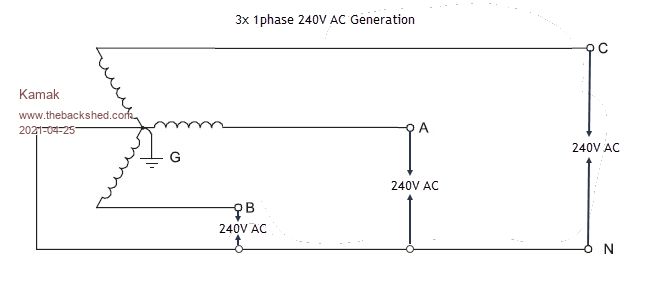
|

|
Forum Index : Windmills : Made to be High Voltage Low Current
| Author | Message | ||||
| Kamak Senior Member Joined: 13/04/2021 Location: CanadaPosts: 150 |
These Washing machine BLDC motors were made to be high speed, high voltage, low current-carrying devices. My thoughts are, keep it that way. The copper or aluminum wire "gauges" found in these motors" are not suited for 10s of amps. It's only suited for less than 5A. High voltage with low amps produces less heat and is inherently capable of traveling long distance with less voltage loss. Yes, it is more dangerous, but in the right hands, with the right approach, and with the right precautions it can be as safe. I wouldn't suggest this approach to the general public but would recommend it to skilled knowledgeable enthusiasts. This is going to be the approach I take, initially, and see where it takes me. Conns Dangerous High Voltages Step-Down transformation High-speed rotor application requirement. Edited 2021-04-25 00:45 by Kamak |
||||
| Technophiliac Regular Member Joined: 18/12/2020 Location: New ZealandPosts: 92 |
Will there be less cogging? Do you have the ability to deal with varying high voltages and do useful things with them? A significant advantage of high voltage is the need for smaller conductor sizes costs etc and therefore the distance the energy can also go more efficiently. There are plenty of disadvantages. For me safety must be attended to but is not otherwise high on the list. (Bearing in mind a 12 volt system can catch fire and that can happen with any voltage associated with any degree of energy.) My observation is that one is best to have a plan of everything in making design decisions with a clear idea (where possible) of objectives. What are you trying to achieve with what generator drivers (Wind, water or?) This is a windmill list. Driving rotors at high speeds in wind implies direct drive noisy wind interfaces or gearing. That may be explanation that I see in the a trend of lower RPM generators no doubt running at higher torques to capture the energy sought. What are you trying to achieve in what circumstances? Davo, Wellington. You can have it perfect, on time, and at the best price. Choose any two. |
||||
| Kamak Senior Member Joined: 13/04/2021 Location: CanadaPosts: 150 |
Well if you are really considering safety, you must consider the amperage created by reducing the voltage of these BLDC motors. The stock wire size (0.6 - 1.0mm) is not suitable for 10+ Amps. It really should be sized as per general guidelines for motor safety designs. 10+ Amps requires 14ga - 12ga wire. not only for thermal reasons but also for reducing voltage drop. Yes, the high voltage does pose a problem of what to do with it. How to step it down to 48V to feed a rectifier, or how to divide it up to feed a bank of DC charging controllers. I intend to build a wind turbine with a planetary gearbox with a high-speed BLDC gen @ high voltage output, to feed a battery bank. Any cogging will be the least worry, it'll be the back driven planetary gearbox torque and the high voltage that will be the biggest issues. |
||||
| Technophiliac Regular Member Joined: 18/12/2020 Location: New ZealandPosts: 92 |
What wattage power are you expecting to get out of this device? What are your wind conditions, mounting means, and height planned, and propeller blade size and speed? Do you have information on the planetary gearbox planned? What are the intended end points / benefits you hope to achieve? Run a 48V DC something...? Maybe a 48 V DC inverter to your mains voltage which is? See where you can go with a fun project? One of the tricks (for economy) is to use readily available relatively low cost components. For example as best I can tell three matching single phase transformers wired in a delta arrangement could be used to drop 3 phase 240V AC to 3 phase 48V AC which is then easy to rectify using standard kit, assuming each transformer had the power capacity required. (Maybe someone knows better?) Depending on the distance thicker wire / lower source voltage might be more economic - or not. Davo, Wellington. You can have it perfect, on time, and at the best price. Choose any two. |
||||
| Kamak Senior Member Joined: 13/04/2021 Location: CanadaPosts: 150 |
Well, maybe something like 480V AC @ 1200W = 2.5A AC, speed would be approx. 1000rpm, through a planetary at the sun gear, with the ring gear spinning at 100rpm, 10:1 Blade size unknown at this point. I need to determine the required torque, and determine what blade/prop diameter would produce said torque. 48V DC @ approx 25A (not considering any losses) would be my intended charge controller endpoint. I could consider DC voltage dividers to multiple charge controllers. http://www.thebackshed.com/forum/ViewTopic.php?TID=13699&P=3#167723 Edited 2021-04-25 11:00 by Kamak |
||||
| Kamak Senior Member Joined: 13/04/2021 Location: CanadaPosts: 150 |
Three fairly cheap single-phase 240V AC to 48V DC 10A adapters might be an option.  But these are not regulating type devices, per se, they won't take a large swing in input voltage. So some kind of switching-on at minimum voltage production of the turbine and max rpm control would be required. There are 10-20A ver, much cheaper, but 200-250V ac gives it some wiggle room. AC-200V-250V-To-DC-48V-50A-2400W-Power-Supply-For-ZVS-High-Frequency-Induction-Heating-Module Edited 2021-04-26 01:12 by Kamak |
||||
| The Back Shed's forum code is written, and hosted, in Australia. | © JAQ Software 2025 |